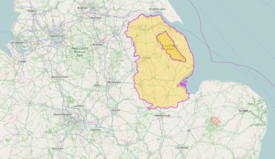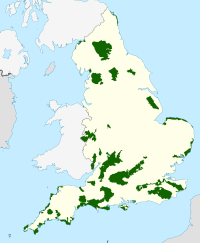Lincolnshire Wolds
| Lincolnshire Wolds | |
|---|---|
  The Lincolnshire Wolds near Stainton le Vale (top), location within Lincolnshire (bottom) | |
| Location | Lincolnshire, England |
| Coordinates | 53°21′0″N 0°6′0″W / 53.35000°N 0.10000°W |
| Area | 560 km2 (220 sq mi) |
| Established | 1973 |
| Governing body | Lincolnshire Wolds Countryside Service |
The Lincolnshire Wolds are a range of low
Geology
The Wolds are formed largely from a series of pure marine
- White Chalk Subgroup
- Burnham Chalk formation
- Welton Chalk Formation
- Grey Chalk Subgroup
- Ferriby Chalk Formation
- Hunstanton Chalk Formation
The thin Hunstanton Chalk and the Ferriby Chalk formations form much of the west facing Wolds scarp but it is the overlying Welton Chalk Formation which forms the greater part of the easterly dip-slopes with the Ferriby Chalk extensively exposed within the dry dip-slope valleys. The Burnham Chalk Formation forms an indistinct secondary scarp to the east of the main scarp between Barton and Louth. In the north between South Ferriby and Grasby, the lower part of the scarp is formed from the Kimmeridge Clay Formation. A series of other rock layers intervene from the Caistor area southwards, uppermost of which are the green-brown Carstones:
Lower/early Cretaceous
- Carstone Formation (sandstone)
- Roach Formation (interbedded mudstone and limestone) (present from Stenigot southwards)
- Tealby Formation (mudstone - but including the 'Tealby Limestone Member')
- Claxby Ironstone Formation
Upper/late Jurassic
- Spilsby Sandstone Formation
- Kimmeridge Clay Formation
The numerous
Geography
The Wolds comprise a series of low hills incised by characteristic dry open valleys.

The Lincolnshire Wolds can be divided into four distinct areas:[2]
- the main area of chalk hills in the north,
- the north west scarp,
- an area of ridges and valleys in the south west,
- the claylands in the south east.
The Red Hill nature reserve near the village of Goulceby is notable for the unusual red colour of its soil and underlying chalk.
Other hills include:
- Castcliffe Hill - TF301735 - 456 feet (139 m)
- Gaumer Hill - TF289778 - 423 feet (129 m)
- Hoe Hill - TF308731 - 417 feet (127 m)
- Meagram Top - TF392789 - 190 feet (58 m)
- Miles Cross Hill
- Tetford Hill - TF326761 - 466 feet (142 m)
- Warden Hill - TF347737 - 371 feet (113 m)
The Wolds provide
Waterways
| Name | Length | Source | Source Elevation (m) | Mouth | Mouth Elevation (m) | Notes |
|---|---|---|---|---|---|---|
| River Bain | Ludford | 130 | River Witham, Dogdyke | 2 | Partly concurrent with the Horncastle Canal south of Horncastle. | |
| Great Eau | North Sea, Saltfleet Haven | 0 | ||||
| River Lud | North Coates
|
0 | Also known as the Louth Navigation due to its canalisation. | |||
| River Lymn | Belchford | 91 | North Sea, Gibraltar Point | 0 | ||
| River Rase | Tealby | 118 | River Ancholme, Bishopbridge | 6 | ||
| River Waring | Belchford | 100 | Horncastle
|
28 |
Area of Outstanding Natural Beauty
The Lincolnshire Wolds were designated an Area of Outstanding Natural Beauty (AONB) in 1973, and are managed as such by the Lincolnshire Wolds Countryside Service.[6][7]
The Wolds AONB covers 560 square kilometres, while the Countryside Service recognises a wider Lincolnshire Wolds Character/Natural Area which incorporates the AONB and the neighbouring areas of the (geographical) Wolds to the north and south.[2]
The Wolds AONB cuts across the council boundaries of Lincolnshire County Council, East Lindsey District Council, West Lindsey District Council and North East Lincolnshire Council.[1][2] The boundaries of the AONB are marked by tourist signs incorporating stylized hills and trees, placed on roads leading into the area.
People and places
The Wolds are sparsely populated and have a
- Alford
- Horncastle, billed on tourist signs as the "gateway to the Wolds", lies just outside the south end of the AONB
- Louth
- Market Rasen
- Caistor
- Spilsby
Many of the place-names in the Wolds indicate a strong
Several notable roads and paths run over the Wolds.
The Wolds are now promoted as a tourist destination: the area's connection with
The area is also popular with
References
- ^ ISBN 978-0319238233.
Lincolnshire Wolds South (Map) (A1 ed.). 1:25000. Explorer. Ordnance survey of Great Britain. 3 April 2006. § 273.ISBN 978-0319238219. - ^ a b c d e "NCA Profile: 43 Lincolnshire Wolds (NE440)". Publications and products. Natural England. Retrieved 13 October 2013.
- ^ "1:50000 Series England and Wales sheet 90, Grimsby (including sheet 91 Saltfleet), Solid and Drift Geology". Maps Portal. British Geological Survey. Retrieved 19 July 2020.
- ^ Kent, Peter (1980). British Regional Geology: Eastern England from the Tees to The Wash (second ed.). London: Institute of Geological Sciences, HMSO. pp. 118–125.
- ^ "Geoindex Onshore". British Geological Survey. Retrieved 18 July 2020.
- ^ "Lincolnshire wolds". Lincolnshire wolds countryside service. Retrieved 13 October 2013.
- ^ "AONB facts and figures". Natural England. Archived from the original on 14 October 2013. Retrieved 13 October 2013.
- ^ "The birthplace of Tennyson". St Margaret's Somersby PCC. Retrieved 13 October 2013.
- ^ "Birth Place of Lord Alfred Tennyson, Somersby, Lincolnshire". Explore Lincolnshire. Archived from the original on 16 October 2013. Retrieved 13 October 2013.
- ^ "Cadwell park race circuit". Retrieved 13 October 2013.
- ^ Miodonski, James (23 August 2014). "BSB Round 8 Cadwell Park". MotoGoLoco.com. Retrieved 30 January 2021.
- ^ "The Viking way". Lincolnshire county council. Retrieved 13 October 2013.
- ^ "The Viking way". Long Distance Walkers Association. Retrieved 13 October 2013.
- ^ "Woody's Top". Youth Hostel Association. Retrieved 13 October 2013.
- ^ "Woody's Top youth hostel". Visit Lincolnshire. Archived from the original on 14 October 2013. Retrieved 13 October 2013.
- "Landscape character". Lincolnshire Wolds Area of Outstanding Natural Beauty. Lincolnshire Wolds Countryside Service. Retrieved 12 October 2013.
- "43 Lincolnshire Wolds". National Character Areas. Natural England. Retrieved 12 October 2013.
- "The Lincolnshire Wolds". Areas of outstanding natural beauty. Natural England. Retrieved 12 October 2013.
- "The Lincolnshire Wolds AONB". Lincolnshire landscapes. Greater Lincolnshire nature partnership. Retrieved 12 October 2013.
- Rawding, C. (2001). The Lincolnshire Wolds in the nineteenth century. Lincoln: History of Lincolnshire Committee.
- The Lincolnshire Wolds Landscape. Landscape Character Assessment. Natural England Publications, Communisis Print Management, Balliol Business Park West, Benton Lane, Newcastle upon Tyne, NE12 8EW: The Countryside Commission. 1993.
{{cite book}}: CS1 maint: location (link)Precursor to the Natural England designation - Thorold., Henry; Yates, Jack (1968). Lincolnshire. The Shell Guide. London: Faber & Faber.
- "Spilsby Sandstone". Lexicon of Named Rock Units. British geological survey. Retrieved 12 October 2013.

